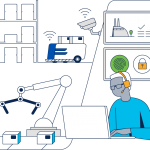Authors: Randal Kenworthy and Doug Wycoff
Innovation in manufacturing comes from many sources. One of the core and traditional sources is the research and development (R&D) function within a manufacturing organization. However, the requirements and traditional processes within those functions are changing.
Manufacturers are beginning to see an increase in the amount of collaborative R&D efforts. That collaboration takes place across geographic boundaries. Increasingly, it also extends outside the traditional walls of the organization to include other companies, suppliers, partners and universities.
Most organizations have a strong desire to enhance collaboration, but there’s also a need to make sure sensitive data is not exposed, data silos are removed and that the manufacturer’s employees are able to visualize diverse data sets independent of location. These abilities help close information gaps between domains to improve the security, speed, and accuracy of product design and research. .
Challenges Facing Manufacturing and Energy
The Manufacturing and Energy (MNE) industry is facing a unique set of IT challenges when it comes to mobile workforces being able to access and visualize data. Many organizational infrastructures are not designed to take on the visualization capabilities necessary for today’s manufacturing and energy workers. A few challenges impacting the industry are:
Computer processing intensive 3D Design applications – From a research and development standpoint, we’re seeing engineers and designers working in applications that require heavy graphic usage – 3D graphics specifically. For example, there are engineers doing visualization of the topography of the landscape, trying to find where there’s oil in the ground and engineers designing the next generation jet engine. These 3D applications are very intensive from a Central Processing Unit (CPU) and Graphics Processing Unit (GPU) standpoint.
More collaborative R&D efforts – Many current organizational infrastructures are not equipped to securely and collaboratively share graphics, drawings and renderings among partners and even fellow offices. Often times today, we’re seeing a 3rd party design company helping with some of the engineering aspects. This requires the ability to share 3D graphic files across multiple parties, globally, both internally and externally within an organization. This means manufacturers now have to deal with engineers outside of their organizations that might be on the other side of the country, or even in another continent.
Security – as Internet of Things (IoT) continues to propagate, the number of vulnerabilities and exposure points for cyber-theft and attacks are increasing.
In order to address these challenges, the industry is leveraging various emerging technologies and innovations. One capability is remote visualization – remote collaboration on 3D graphics and visualization, through a unified infrastructure. Cisco is now helping create an optimized solution that accelerates the GPU capabilities of a VDI solution.
Benefits of a VDI-Enabled Unified Infrastructure
Recently, an oil and gas exploration company incorporated a unified infrastructure solution called FlexPod Datacenter with NVIDIA and Citrix. FlexPod enables you to centralize important datasets in one or a few locations and make the results of visualization available wherever they are needed. Centralizing data simplifies data integration between systems and accelerates workflows across functions (geophysics, geology, reservoir and simulation). Your geoscientists, engineers, and business decision makers can see important results in real-time, without the bottlenecks that result from transferring huge data sets over network connections or by mail. A few additional benefits include:
- Eliminate the infrastructure challenges created by ever-growing datasets.
- Improve collaboration within your organization.
- Make visualization available where and when it’s needed, including on mobile devices—without local data copies.
- Allow you to share the results of visualization across organizational boundaries while keeping valuable datasets secure.
Similarly, imagine a defense manufacturer has a large 3D design file that has been shared within the organization and amongst partners. Let’s assume that it’s on 30 different PCs in different countries. The ability for this company to manage, track and protect those 30 designs is challenging because it’s so distributed and hard to know what security levels all partners have in place. Under the FlexPod solution, there is one version of that design/drawing and it’s in a centralized data center that you manage and protect. With this, organizations have better control over what cyber security protection they have around it and also have better control of the actual files. Data centers are not 100 percent threat proof, but they are more secure and much more manageable than if the data was distributed across multiple PCs across the network.
This ability to manage top-secret information is why one defense manufacturer worked with Cisco to build a VDI platform that met all Department of Defense (DOD) security requirements.
No matter how carefully you plan, there can be unforeseen needs and opportunities that result in a requirement for more compute infrastructure in a hurry. Whether it’s in an existing data center, or a remote location, the integrated and tested design of FlexPod Datacenter means that you can have new infrastructure up and running in less time with less effort, providing a distinct competitive advantage in situations where time is of the essence.
Seeing is Believing
A real-time clip of the VDI solution rendering a 3D Visualization application:
To learn more about visualizing data sets and incorporating a unified infrastructure for enhanced R&D collaboration, visit our solutions page. To see this solution firsthand, visit Cisco in booth 709 at SEG 2014. Together with partners NetApp, NVIDIA and Citrix, we’ll showcase how this solution enhances collaboration and enables faster decision making without exposing sensitive data.

CONNECT WITH US